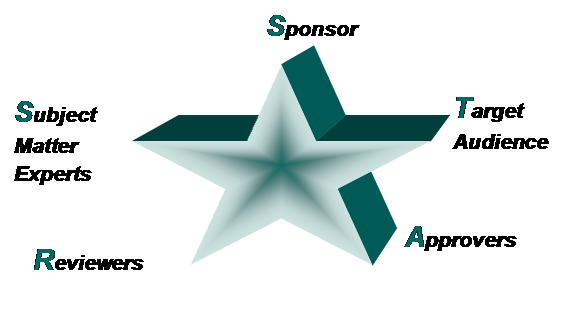Sam: An SME Story
For the past two months you’ve been working with Sam, your Quality Assurance expert. He’s provided you content you need for a course you’re developing although it’s been challenging to get his time and commitment. Now you are in the final review phase and must have Sam’s input. You’ve sent two e-mails and received no reply.
Does this sound familiar? You could ask, “What should I do next?” But, I’d rather focus on, “What should I do next time?” and look at the process more holistically.
Instructional designers often need to work with experts in a particular content area. These are our subject matter experts (SMEs). We need SMEs when we are asked to develop a course in a field in which we may not have expertise. For example, when developing a course on managing risk, budgeting, or delivering performance reviews, we need to obtain job-specific content from someone in the Risk Management, Finance, or Human Resources groups.
One of the challenges of identifying and working with SMEs who will meet the needs of your project is their “expert” status–they are very good at what they do and so are often called upon from other parts of the business to participate on task forces, project teams, and other special assignments. And, of course, they also need to perform their “regular” jobs. Where does that leave you when competing priorities pull the SME away from your training project?
In this post we provide a checklist: What to look for in an SME and, at least as important, how you can prepare and support your SME. Check out our SME Checklist.
At project close, be sure to thank your SME and show appreciation for the work your SME performed. Based on the SME’s personal style, you may choose a private thank you (such as a personal note) or a more public acknowledgement (an article in a corporate newsletter highlighting your SME’s role or a note to the SME’s divisional director, for example).
The next time you engage a subject matter expert try sharing this checklist, or parts of it as appropriate to your situation, with your SME.
Making Instructional Design REAL
Have you ever sat through a course that was not engaging and had minimal activities? How much information did you retain?
Worse yet, have you ever delivered a course, and the participants seemed bored and uninterested? Here is a model for making instructional design REAL.
R is for reality-based
This is critical. Be sure your course teaches what the audience needs and the audience needs what is being taught and they will use what they learn very soon. If learning is too theoretical or won’t be applied within days, re-evaluate your approach. Considering the following information during the needs assessment phase will help ensure the course is pertinent and timely:
- Who is the target audience?
- What do they need to do differently on the job?
- When do they need to start doing it?
- What are the consequences if they don’t perform to the new standards?
- What might be preventing their success?
- Do all members of the target audience need to know the same information and perform the same skills?
E is for engaging
Learners want to be engaged and need to easily understand how what they are learning is meaningful to them. So, design engaging interactions throughout the course that address this need. You can set the stage by starting out with “what’s in it for me” information.
For example, if you are delivering a course on writing performance reviews you could post a flip chart listing challenges commonly faced by managers writing reviews. As participants enter the classroom, ask them to check off all those challenges they’ve encountered and to add any not listed. You now know which topics to emphasize.
Remind learners throughout the course how the content will benefit them. Better yet, have learners tell you! For example, after you’ve identified and practiced ways to manage a challenging employee situation during a performance review discussion, you could ask learners, “How will this be helpful to you?” Eliciting just a couple of responses will help engage your audience and get them thinking about how they will use the knowledge and skills being taught.
A is for action-oriented
Action-oriented design, quite simply, helps learners learn. It also helps them process and apply what they are learning thus increasing learning effectiveness. Ideally, you will include a significant activity relating to each learning objective. Consider the following as you design your course:
- Are participants working in activities for at least half the class? If not, think of more ways to have learners apply the concepts and skills being taught.
- Activities where learners need to move around helps the learning process even more. For example, if you are teaching about a work process, have learners recreate the process flowchart by standing in the correct order around the room based on their assigned step. Then ask them to explain what is involved in their step and what data or items are passed to the next step.
- At a loss for an activity? After covering a topic, ask pairs to summarize three key points they just learned, or ask them to state one thing they’ll do differently at work.
L is for learner-focused
As the instructional designer (or the instructor), it is your job to focus on the learner’s perspective rather than trainer’s. Turn courses with lots of lecture (or, in elearning, lots of reading) into learner-centric events. Consider the following questions:
- Are you eliciting information from the learners, leveraging what they already know and reinforcing that knowledge?
- How are learners practicing required job skills in a safe classroom environment?
- What concerns does the learner have about the new information? How is that being addressed in the course?
Making it REAL—Reality-based, Engaging, Action-oriented, and Learner-focused—is one way to help ensure your course design will be effective. Use the REAL checklist anytime you design a course.
Align your STARS – The People Who Make It Work
Even the most experienced trainers and instructional designers face challenges in their roles when the people supporting their jobs are not in place. Here are some of the critical people who help make your training project a success, your STARS:

You may work with most or all of these groups of people on any training project. We’ve defined their roles below, with key questions to ask yourself about the partners in your endeavor and recommended critical actions to help ensure project alignment.
- Your project sponsor is usually the person requesting and possibly paying for the training.Is your sponsor committed? Will your sponsor provide all the resources you’ll need to complete the project on time? At the beginning of the project, meet with your sponsor to review his or her expectations and what support you will need to meet those expectations. This conversation should include the business rationale for the training and set the stage for ongoing communication during the project. Your sponsor may help you identify the rest of your STARS.
- The target audience includes individuals who will receive the training—or their representatives. Keep this group in mind throughout the design and development process—avoid letting subject matter experts (SMEs), the sponsor, or the approver speak solely on their behalf! Have you scheduled a pilot comprised of your target audience to give you valuable and necessary feedback regarding content appropriateness and training effectiveness? Remember to keep diversity in mind; involve target audience members from a variety of work sites, departments, and experience levels. Include some of the target audience in the review process.
- The approver is usually one of the subject matter experts who is responsible for reviewing all course materials and signing off on final versions. You may ask the approver to assess all reviewer comments and provide you with the final change requests. Is the approver in a position to decide on conflicting reviewer change requests and to respond to and resolve business questions that impact the training? Will the other resources accept the approver’s decisions? It is best to have one approver. However, if you have multiple approvers, agree in advance on a method to obtain final approval. This may be through an online collaboration and communication or an in-person meeting among all the approvers, for example.
- Reviewers are individuals you, your sponsor, and subject matter experts have identified to review and comment on all the training materials at key points during design and development. Do reviewers represent all stakeholder groups (e.g., line of business the training targets, finance, human resources, and legal)? Have you communicated the expectations to reviewers, and are they on board? You can use a number of methods to collect reviewer feedback, and you will need to determine which method works best for your team. Ideally, you will end up with one document of reviewer comments from which the approver decides on final change requests.
- Subject matter experts should be very knowledgeable about one or more topics related to the training. Do you have all content areas covered by one or more SMEs? Sometimes you will need multiple SMEs to cover all aspects of a project. Agree ahead of time which SME is the “lead” decision-making authority for each topic. Are the SMEs committed and engaged? Communicating mutual expectations ahead of time—including project goals and timelines, what you need from the SME and why, estimated time commitment and any planned meetings, and support you will provide—will help SMEs understand their roles. Encouraging the sponsor to deliver this message will go a long way in engaging the SMEs.
One more point: If you are developing instructor-led training, including some of the trainers throughout the design and development phase will help ensure buy-in and a successful delivery. Finding out what works for them will help the instructional designer provide the level of detail needed.
Once you’ve aligned your STARS and have clearly set mutual expectations, you can focus on the design and content of your training.


